Herbicide
Group A - Inhibitors of ACCase
Group A consists of chemicals that target acetyl coenzyme A carboxylase, an enzyme involved in lipid synthesis
Chemistry and mode of action
Group A herbicides are only active against grass species and are often known as graminicides because of this. Two distinct herbicide chemistries, the aryloxyphenoxypropanoates (APPs) and the cyclohexanediones (CHDs), share the same target enzyme acetyl-coenzyme A carboxylase (ACCase). Examples of each of these chemistries are given in Figure 11.1.
Acetyl-coenzyme A carboxylase catalyses the first committed step in the biosynthesis of fatty acids. This enzyme is particularly important in rapidly growing tissue like shoot and root meristems where there is a high requirement of fatty acids for membrane synthesis. To be fully effective, these herbicides need to be translocated to plant meristems. The APP herbicides are formulated as esters to aid penetration of the cuticle. Once inside the plant, the ester is rapidly cleaved by a non-specific esterase, converting the herbicide to its acid and toxic form.
| Aryloxyphenoxypropanoate (APP) | Cyclohexanedione (CHD) |
 |
 |
| Diclofop-methyl | Sethoxydim |
Figure 1. Chemical structures of representative APP and CHD herbicides.
Weed symptoms of Group A herbicides typically include:
- necrosis
of the meristematic region
- chlorotic spots on leaves
- cessation of plant growth. Death of the plant is normally evident in about two weeks from the time of application
Use and selectivity
The Group A herbicides have little soil activity so are applied post-emergent. Herbicides from Group A are selective in that they kill grass weeds without damaging broadleaf crop or weed species (see table below). This selectivity is a result of structural differences in the target enzyme in grass plants compared to broadleaf plants. Grass species contain within their plastids a multi-functional ACCase that is sensitive to ACCase-inhibiting herbicides, whereas the ACCase of broadleaf plants is a multi-subunit enzyme that is inherently resistant to these chemistries.
Some Group A herbicides can be selectively used in cereals such as wheat and barley (see table below). This is because these cereals can rapidly detoxify these herbicides to inactive products. Tolerant wheat contains a cytochrome P450 - dependent microsomal oxidase that can rapidly hydroxylate diclofop acid rendering the herbicide non-toxic. A similar mechanism endows tolerance of wheat to tralkoxydim; however, it appears that fenoxaprop acid might be metabolised by both a cytochrome P450-dependent microsomal oxidase and by non-enzymatic glutathione conjugation.
With herbicides such as fenoxaprop-p- ethyl and clodinafop-propargyl the degree of tolerance of the crop species is small. To avoid unacceptable damage to the crop with these products, the manufactures have included a compound called a safener in the formulation. The role of the safener is to increase metabolism of the herbicide in the crop species and hence increase the level of tolerance to the herbicide. APP and CHD herbicides used in Australia are:
Group B - Inhibitors of ALS
Group B consists of chemicals that target acetolactate synthase, an enzyme involved in protein synthesis via branched chain amino acid synthesis.
Chemistry and mode of action
There are four chemically distinct classes of group B herbicides that all inhibit acetolactate synthase (ALS). These are:
- sulfonylureas
- imidazolinones
- sulfonamides
- pyrimidinylthiobenzoates (Figure 11.2)
The Group B herbicides are some of the most successful broad area herbicides used world wide and are important in:
- crops
- the control of weeds in bush
- the control of weeds on roadsides
- the control of weeds in industrial situations
Two negative features of these herbicides are:
- their extended persistence in some soils, leading to damage to subsequent crops or to desired native species
- the rapid emergence of herbicide resistance to this mode of action
The two features of the Group B herbicides that have been instrumental in their success are:
- very low toxicity to most mammals - ALS inhibitors block the branched-chain amino acid pathway. The branched-chain amino acids, valine, leucine and isoleucine, are essential amino acids in the diet of animals, and animals do not have ALS.
- many ALS-inhibiting herbicides are also exceedingly potent against the target enzyme and some of these products are used at very low rates, down to 3 gha-1
Symptoms of ALS-inhibitor toxicity are:
- cessation of growth
- the appearance of a characteristic reddening of the leaf
margins or the stem caused by accumulation of anthocyanins. New leaves that
emerge are frequently stunted and malformed
- root growth is particularly sensitive to inhibition by ALS inhibitors and may be totally inhibited
 |
 |
| Sulfonylurea (Chlorsulfuron) | Imidazolinone (Imazethapyr) |
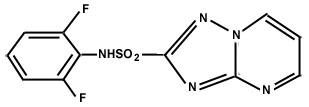 |
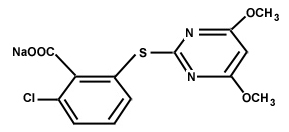 |
| Sulfonamide (Flumetsulam) | Primidinylthiobenzoate (Pyrithiobac-sodium) |
Figure 11.2. Chemical structures of representative ALS-inhibiting herbicides.
Use and selectivity
Both roots and shoots of plants can absorb ALS-inhibiting herbicides. Many of these compounds are applied pre-emergent to control germinating weeds. Others are more effective as post-emergent applications. Many ALS-inhibiting herbicides are selective in one or more crop species. Frequently, selectivity can vary extensively from crop to crop eg.:
- chlorsulfuron is selective in wheat and barley crops but will kill most broadleaf crops.
- imazethapyr is selective in pulse crops, but severely damages cereals.
In all cases, selectivity is based on more rapid detoxification of the herbicide by the tolerant crop with cytochrome P450-dependent microsomal oxidases playing a key role. In some examples, susceptible species are barely able to metabolise the herbicide at all. Group B herbicides are:
Group C - Inhibitors of Photosystem II
Group C consists of chemicals that target Photosystem II, a key step in photosynthesis.
Chemistry and mode of action
The Group C herbicides are a widely divergent group comprising some seven herbicide chemistries. Examples of three important groups are illustrated in Figure 11.3.
The following paper gives a brief description of the photosynthetic process and describes the interactions of PS II-inhibiting herbicides with PS II. You should note that these interactions result in the production of toxic oxygen radicals. The damaging effects of uncontrolled radical production are also discussed in this paper. This paper also discusses mode of action of the Group L herbicides that interact with Photosystem I. These herbicides will be covered in detail later in this section of the Study Guide and I will refer you back to this paper at that time.
|
| Triazine | Substituted urea | Nitrile |
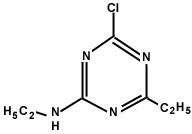 |
 |
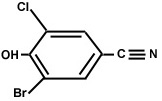 |
| Simazine | Diuron | Bromoxynil |
Figure 11.3. Structures of representative PS II-inhibiting herbicides.
A number of herbicide modes of action have effects mediated by toxic oxygen species like the Group C herbicides. Symptoms of PS II inhibitors are slow bleaching of leaves often starting at the margins or tips.
Use and selectivity
The PS II-inhibiting herbicides are particularly effective against young broadleaf weeds; however, many products will also control annual grasses. These herbicides often have extensive soil activity with absorption into the plant occurring mainly through the roots. Group C herbicides are normally applied to bare, moist soil and may need rainfall or irrigation after application for maximum effect. Selectivity with Group C herbicides may be due to either metabolism of the herbicide by the crop, or separation of crop and herbicide.
Atrazine is rapidly metabolised by maize and sorghum crops by glutathione conjugation mediated by glutathione-S-transferases. With other PS II inhibitors such as fluometuron, N-dealkylation reactions mediated by cytochrome P450 oxygenases are the initial detoxification process.
Metribuzin can be metabolised by N-deamination mediated by cytochrome P450 oxygenases, or by sulfoxidation followed by homoglutathione conjugation. Other Group C herbicides can be detoxified in other ways to obtain selectivity.
Where Group C herbicides are not rapidly metabolised, they can still be used selectively by directed spraying between rows of tree or row crops, or to established lucerne crops that are winter dormant. These latter applications rely on the herbicides not being readily leached to the deeper layers of soil where the roots of the crop are.
Group D - Inhibitors of tubulin elongation
Group D consists of chemicals that target tubulin elongation involved in cell division
Chemistry and mode of action
There are two chemistries making up this group in Australia.
- dinitroaniline herbicides is the most important chemistry, comprising trifluralin, oryzalin, and pendimethalin
- chlorthal dimethyl is the other chemistry which is the sole commercial compound
These herbicides act by inhibiting tubulin polymerisation and the formation of microtubules. Microtubules play a vital structural role in:
- plant cells creating and maintaining the internal architecture of cells
- separation of the chromosomes during mitosis.
Dinitroaniline herbicides attach to the growing end of microtubules and to tubulin heterodimers. This stops elongation of microtubules, and as microtubules are continuously degraded from the other end, shortened microtubules result. The early stages of the cell cycle proceed normally in dinitroaniline-herbicide treated cells; however, the chromosomes do not coalesce and separate, but remain dispersed in the cytoplasm. Eventually a nuclear membrane may form around the doubled nucleus, but takes on a highly lobed appearance.
Dinitroaniline herbicides are only effective against young germinating seedlings and typical symptoms include:
- reduction in root and shoot length
- deformations of roots and shoots
Dinitroaniline herbicides do not affect mitosis of animal cells and hence are not toxic to mammals.
Use and selectivity
The dinitroaniline herbicides are highly lipophilic and frequently volatile. These characteristics affect their formulation and use. Because the dinitroaniline herbicides are effective against germinating seedlings, they are normally applied pre-emergent and inhibit germination of many annual grasses and some broadleaf weeds. Selectivity of these herbicides is principally the result of placement.
The herbicides are applied to soil and usually incorporated into the top few cm of soil to reduce losses due to volatilisation (see Module 15). Weed seeds that germinate within the soil band containing herbicide absorb the herbicide and are killed. Crops can be protected from damage caused by dinitroaniline herbicides by sowing the crop seeds below the band containing the herbicide. As the dinitroaniline herbicides normally do not leach down the soil profile, the crop will grow through the herbicide band and survive.
Group E - Inhibitors of mitosis
Group E consists of chemicals that target mitosis.
Chemistry and mode of action
There are three types of Group E herbicides:
- carbamates
- thiocarbamates
- organophosphates
This represents a diverse group which all appear to inhibit mitosis. However, the exact modes of action of these herbicides are not all known. Group E herbicides and their mode of action:
| Herbicide | Mode of action |
| Triallate, EPTC, molinate, pebulate, benthiocarb, and vernolate (thiocarbamates) | inhibitors of long chain fatty acid biosynthesis, gibberellin biosynthesis and other reactions |
| Bensulide (organophosphate herbicide) | inhibits root elongation and cell division, through an as yet unknown mechanism |
| Chlorpropham (carbamate herbicide) | inhibits cell division, RNA synthesis and protein synthesis; however, the target site of this herbicide is not known |
Use and selectivity
One characteristic all of these herbicides have in common is that they are all soil applied and are primarily active against emerging seedlings of grass weeds. Most of these herbicides require incorporation or irrigation to move them into the soil zone where the weed seeds are. Like the Group D herbicides, the Group E herbicides are not usually leached within the soil profile and so they are long acting. Selectivity can be obtained by sowing the crops below the herbicide zone.
Group F - Inhibitors of carotenoid biosynthesis
Group F consists of chemicals that target carotenoid biosynthesis
Chemistry and mode of action
There are three types of Group F herbicides:
- nicotinanilides
- aminotriazoles
- pyridazinones
They are grouped together because of their similar symptoms they may induce in the weed that are susceptible. Diflufenican (a nicotinanilide) and norflurazon (a pyridazinone) are inhibitors of phytoene desaturase a key enzyme in the carotenoid biosynthesis pathway. Some other herbicides in this mode of action (e.g. benzofenap) inhibit plastoquinone synthesis. Plastoquinone is a cofactor required for the synthesis of carotenoids.
The actions of these herbicides lead to a loss of carotenoid pigments that are involved in protection of the photosynthetic apparatus from excess energy. The carotenoids harmlessly dissipate excess energy within the photosynthetic apparatus. Without carotenoids, the photosynthetic apparatus becomes damaged by oxygen radicals (see Group C herbicides) and bleaching of leaves occurs.
Amitrole (an aminotriazole) is also an inhibitor of phytoene desaturase, but in addition inhibits a range of other enzymes including lycopene cyclase (also in the carotenoid biosynthesis pathway), imidazoleglycerol phosphate dehydratase (a key enzyme in the histidine biosynthesis pathway), and catalase. The mode of action that is responsible for amitrole toxicity in plants has not been fully elucidated.
Use and selectivity
The herbicide in this group, target a wide range of weed species including broadleaf species, annual grasses and one used in cereal cropping legumes and in the horticultural industry. Group F herbicides used in Australia:
Group G - Inhibitors of chlorophyll synthesis
Group G consists of chemicals that target photosynthesis by inhibiting chlorophyll synthesis.
Chemistry and mode of action
There are three classes of herbicide chemistry in the group viz:
- diphenyl ethers (oxyfluorfen and acifluorfen)
- oxadiazoles (oxadiazon)
- triazolinone (carfentrazone-ethyl)
They all inhibit chlorophyll synthesis by the inhibition of protoporphrinogen oxidase (Protox) a key enzyme in the synthesis of haem and chlorophyll. Inhibition of Protox leads to a transitory accumulation of protoporphyrinogen IX, the substrate for this enzyme, which is then oxidised to protoporphyrin IX. Protoporphyrin IX is the normal product of Protox; however, it is believed that when Protox is inhibited protoporphyrin IX is formed in an environment where it cannot be used as a substrate for subsequent reactions in chlorophyll biosynthesis.
Protoporphyrin IX accumulates within the cell and absorbs light resulting in a highly reactive triplet state. This compound reacts with oxygen, forming singlet oxygen and regenerating protoporphyrin IX. The singlet oxygen begins a cascade of reactions leading to loss of membrane integrity and bleaching of pigments (see Group C herbicides).
Symptoms of Group G herbicides are:
- bleaching of pigments
- tissue necrosis, and
- tissue desiccation within a few days
These herbicides require light for activity.
Use and selectivity
Group G herbicides are normally applied pre-emergent or early post-emergent to control young annual weed seedlings. Carfentrazone-ethyl is registered for the post-emergent control of broadleaf weeds, particularly wild radish and bifora in cereals. The mechanisms of crop selectivity of these herbicides have not been well studied; however, it is believed that cleavage of the ether bond of acifluorfen by homoglutathione endows selectivity in soybeans. Herbicide placement can also be used as a means of selectivity for these herbicides.
Group I - Disruptors of plant cell growth
Group I consists of chemicals that target cell growth
Chemistry and mode of action
The Group I herbicides, commonly known as hormone herbicides or hormone mimics, are represented by three chemistries:
- phenoxyacetic acids (2,4-D, 2,4-DB, and MCPA)
- benzoates (dicamba)
- pyridinecarboxylates (picloram, fluroxypyr, triclopyr, and clopyralid)
All of these herbicides are chemical and functional mimics of indoleacetic acid, the natural plant auxin (Figure 11.4). It is believed that the Group I herbicides interact with the normal auxin recognition mechanism in cells and result in uncontrolled auxin mediated responses in the plant.
The characteristic symptoms of these herbicides are:
- epinasty
- twisting of stems and petioles
- stem swelling, and adventitious root production
- later, growth inhibition and chlorosis of the growing tips occur
- susceptible plants take 3 to 5 weeks to die
| Indoleacetic acid | 2,4-D | Triclopyr |
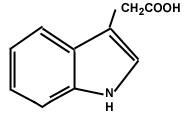 |
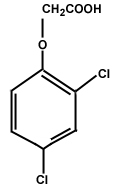 |
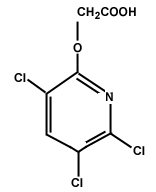 |
Figure 11.4. Comparison of chemical structures of indoleacetic acid and Group I herbicides.
Use and selectivity
The Group I herbicides can normally be absorbed by both roots and shoots; however, some of these compounds such as 2,4-D are rapidly degraded by microbes in the soil and have little long-term soil activity. Some other compounds such as picloram have extended soil activity and soil residues can damage susceptible crops if they are planted within 12 months of herbicide application.
The Group I herbicides are used to control broadleaf weeds in cereals and pastures, but grass species are not normally controlled by these herbicides. In addition to annual weeds, some products can also be used to control perennial and woody weeds. Selectivity in grass species is based on more rapid metabolism of the herbicide, with cytochrome P450-mediated hydroxylations and demethylations being important.
Group J - Inhibitors of cell wall synthesis
This mode of action of Group J chemicals is characterised by the alkanoates, represented by TCA, dalapon, and flupropanate. These herbicides control grass growth in pastures and non-crop areas. These are slow acting herbicides that are persistent in the soil. The exact mode of action is unknown; however, some compounds such as flupropanate inhibit new growth with little effect on existing tissue.
Group K - Other modes of action
This is a diverse group of compounds with largely unidentified modes of action. Some examples are:
| Herbicide | Mode of action | Application/Affects |
| Chloroacetamide | ||
| Metolachlor | Inhibit the biosynthesis of fatty acids (possibly by affecting desaturation reactions), protein synthesis, gibberellin synthesis, and flavonoid synthesis | Susceptible seedlings fail to emerge or have tightly rolled leaves and stem twisting |
| Propachlor | ||
| Amide | ||
| Propyzamide | Inhibitor of mitosis, like the dinitroaniline herbicides | Normally applied pre-emergent and need to be incorporated mechanically or by irrigation. Affect emergence of susceptible seedlings. Selectivity in crop species is normally the result of rapid metabolism of the herbicide by the crop. |
| Napropamide | Inhibitor of mitosis, but through a different mechanism, as DNA synthesis is inhibited. This herbicide also inhibits a-amylase, an enzyme responsible for the conversion of starch to simple sugars in the germinating seed | |
| Phenyl-carbamate | ||
| Asulam | Iinhibition of cell division and expansion in plant meristems, whereas existing leaves are affected more slowly | Post-emergent herbicides which are readily absorbed by foliage |
| Phenmedipham | Inhibitor of PS II (see Group C herbicides), but this may not be its only mode of action | |
| Organic arsenic | ||
| MSMA (monosodium methylarsenate) | Probably acts by interfering with respiratory processes | Post-emergent herbicide readily absorbed by foliage. It is rapidly and strongly adsorbed to soil and has little soil activity.Symptoms include rapid desiccation of leaf tissue. |
| Benzofuran | ||
| Ethofumesate | The mode of action is unknown. | Either pre- or post emergent for the control of some grass and broadleaf weeds in beets, onions or in ryegrass pastures. |
| Aminopropanoate | ||
| Flamprop-methyl | The mode of action is unknown, but the herbicide inhibits elongation of internodes | Used to control wild oats in wheat. Late post-emergent application once the wild oat plants have tillered. Selectivity is the result of differences in metabolism between wheat and wild oats. Wheat de-esterifies flamprop-methyl to flamprop acid more slowly than wild oat, but detoxifies flamprop acid more rapidly. Therefore, wild oats contain a higher concentration of the toxic flamprop acid for longer than does wheat. |
Group L - Disruptors of Photosystem I
Group L consists of chemicals, that target photosynthesis by disrupting Photosystem I.
Chemistry and mode of action
The bipyridyl herbicides, paraquat and diquat, are members of Group L. These are rapidly acting herbicides that cause bleaching and wilting of green leaf tissue. Paraquat and diquat are divalent cations that act by accepting electrons from photosystem I in photosynthesis. After accepting an electron from PS I, a bipyridyl radical results. These radicals are very unstable and rapidly donate the excess electron to molecular oxygen forming superoxide and regenerating the bipyridyl cation.
Superoxide is highly reactive, but is detoxified within plants by the enzyme superoxide dismutase. The product of this reaction, hydrogen peroxide, is also toxic and, in addition, can react with the bipyridyl radical to produce highly reactive hydroxyl radicals. This cascade of radicals damages the fatty acid side chains of lipids resulting in loss of membrane integrity and cell death (see Fuerst and Norman, 1991). In strong light paraquat is an exceptionally rapidly acting herbicide and damage can be observed within a few hours of application.
Use and selectivity
Paraquat and diquat are rapidly and strongly bound to soil colloids and have no soil activity. Paraquat and diquat are used as non-selective herbicides for total weed control. Generally, grass weeds are more susceptible to paraquat and broadleaf weeds more susceptible to diquat.
Major uses for paraquat and diquat are as a pre-sowing knockdown herbicide, for control of seed set of annual grasses in pastures (pasture topping), for control of annual ryegrass (Lolium rigidum) seed set in certain pulse crops (crop topping), control of annual weeds in established lucerne and orchards, and for weed control in fallows. As these are non-selective herbicides, selectivity can only be achieved by not allowing the herbicide to contact foliage of desirable plants.
Group M - Inhibitors of EPSP synthase
Chemistry and mode of action
Glyphosate acts by inhibiting the enzyme 5-enolpyruvylshikimate-3-phosphate (EPSP) synthase, a crucial enzyme in the shikimate pathway leading to the biosynthesis of the aromatic amino acids, phenylalanine, tyrosine, and tryptophan. This pathway is found only in plants and glyphosate is not toxic to animals. The shikimate pathway is of enormous importance to plants and an estimated 20% of all carbon passes through it. EPSP synthase has been extensively studied and glyphosate established as a competitive inhibitor of the enzyme. The plant dies from starvation for aromatic amino acids and other products of the shikimate pathway.
Use and selectivity
Glyphosate is non-selective and like paraquat is readily adsorbed to soil. Unlike paraquat, glyphosate is well translocated in the plant and can be used to control perennial species and species with underground rhizomes, bulbs or other vegetative structures. Glyphosate is used for total vegetation control in non-crop situations, for weed control prior to sowing, for weed control in orchards and vineyards, and for control of seed set of annual grasses in pastures.
Glyphosate is also the most important herbicide used for control of weeds in native ecosystems. Care must be taken with glyphosate that it does not contact the stem or foliage of desirable plants. Glyphosate is a slowly acting herbicide and death of the plant may take more than a week.
Group N - Inhibitors of glutamine synthetase
Chemistry and mode of action
Glufosinate is a derivative of a naturally occurring bacterial compound (alanyl-alanyl-phosphinothricin) produced by some Streptomyces spp. Glufosinate is an inhibitor of glutamine synthetase, an enzyme responsible for ammonium assimilation in plants. Glufosinate is a contact herbicide and not readily translocated within the plant. This means that it has its major activity in leaves.
There are two main sources for ammonium within plants; the first is the nitrogen absorbed by roots from the soil, the second is ammonium released during the photorespiratory C2 pathway. Inhibition of glutamine synthetase by glufosinate results in an accumulation of ammonium within the tissue that eventually reaches toxic concentrations.
In addition, photosynthetic carbon fixation is inhibited. This leads to a build up of electrons within the photosynthetic electron transport chain and creation of toxic oxygen radicals as described for the Group C herbicides. It is probably a combination of ammonium poisoning and the effects of oxygen radicals that kill cells.
Use and selectivity
Glufosinate is a non-selective herbicide used for the control of a range of weed species in orchards, tree crops and industrial situations. Glufosinate is rapidly degraded in soils and has no soil activity.